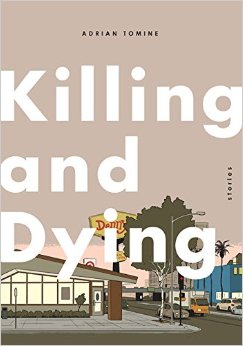
News
Pro-Palestine Encampment Represents First Major Test for Harvard President Alan Garber

News
Israeli PM Benjamin Netanyahu Condemns Antisemitism at U.S. Colleges Amid Encampment at Harvard

News
‘A Joke’: Nikole Hannah-Jones Says Harvard Should Spend More on Legacy of Slavery Initiative

News
Massachusetts ACLU Demands Harvard Reinstate PSC in Letter

News
LIVE UPDATES: Pro-Palestine Protesters Begin Encampment in Harvard Yard
Adrian Tomine On Boldness and Befuddlement
"Killing and Dying" by Adrian Tomine (Drawn & Quarterly)

Graphic novelist and illustrator Adrian Tomine visited the Harvard Book Store with fellow artist Leanne Shapton last Thursday to speak about his newest graphic novel “Killing and Dying.” Tomine, a New York Times Notable Book award winner, is well-known for illustrating New Yorker cover art and starting his Optic Nerve comic book series at the young age of sixteen. His work explores human nature and the complex feelings that come with everyday interactions using subtle and poignant illustrations. A few days before his and Shapton’s event, The Harvard Crimson spoke with Tomine about “Killing and Dying” and the processes that went into the creation of this graphic novel.
The Harvard Crimson: Do you see any of your own experiences from being a father, or husband, or even living in Brooklyn reflected in the stories you write?
Adrian Tomine: [“Killing and Dying” is] kind of me thinking back and imagining myself back in the California environment that I grew up in. I don’t think I would be so interested in the little precise details of these suburban strip malls if I was still living in the middle of them.
I think being married changes the focus of the work a lot. My early comics are really reflective of being kind of a befuddled, single loser in the Bay Area, and I think having kids has been by far the most profound impact on me as a person and as an artist. I didn’t set out to make “Killing and Dying” about parents and children or anything like that. I wasn’t even thinking of it consciously [but] when the book was finished I looked back on it and thought…. almost every story somewhat relates to parental responsibility or the failure of it.
THC: What were you hoping to accomplish with this graphic novel?
AT: I was really pushing myself to tap into feelings and thoughts that I might have been nervous about in the past, and to be really ruthless about cutting out things that I thought might be too sentimental or cliche.
THC: How did you get in touch with those feelings and anxieties in the process of creating “Killing and Dying?”
AT: What was a very private childhood hobby turned into a very a public, professional job and I think that there’s a lot of inhibition that can grow from that. For me, one of the things that I consciously did with “Killing and Dying” was put myself back in the mindset of working as a complete amateur [when] I was doing stuff for myself and for my own enjoyment and not worrying so much about how it was going to be received. [However,] a lot of personal, subconscious, personal things started seeping into it and I kind of just allowed them to flow in.
THC: Your stories sometimes differ from each other stylistically. For example, “Translated, from the Japanese,” a story in “Killing and Dying,” has no lines bordering its panels or blocks of text. Why is this?
AT: A lot of it has to do with what would most effectively tell the story. The kind of detailed illustrations that i did for “Translated, from the Japanese” would be very cumbersome with a story like “Go Owls” where I’m just trying to communicate with the dialogue and action.
[It’s] also just trying to enjoy the freedom of doing a short story collection. To me, one of the big fears of doing a big huge graphic novel is locking yourself into one style and getting halfway through it and going “Oh I made the wrong choice,” which is a recurring nightmare I have.
THC: “Killing and Dying,” is composed of six stories: “A Brief History of the Art Form Known as ‘Hortisculpture,” “Amber Sweet,” “Go Owls,” “Translated, from the Japanese,” “Killing and Dying,” and “Intruders.” Why choose to make “Killing and Dying” the title of your graphic novel?
AT: “Killing and Dying” was actually the one that my publisher and I immediately ruled out. It’s like the two words that people hate to think about the most. And then, the more I started thinking about it, I thought like “You know, I have this sort of history of doing books [that are] very quiet and gentle.” I’ve always wanted to do something a little bolder. I thought, “Yeah, let me go with the boldest and most perplexing title…. This isn’t the time for me as an artist to stick my publisher and booksellers across the country with an obscure looking book with a forgettable title. These are kind of desperate times and I need to make a book that will get people’s attention.”
—Staff writer Grace Z. Li can be reached at grace.li@thecrimson.com
Want to keep up with breaking news? Subscribe to our email newsletter.
